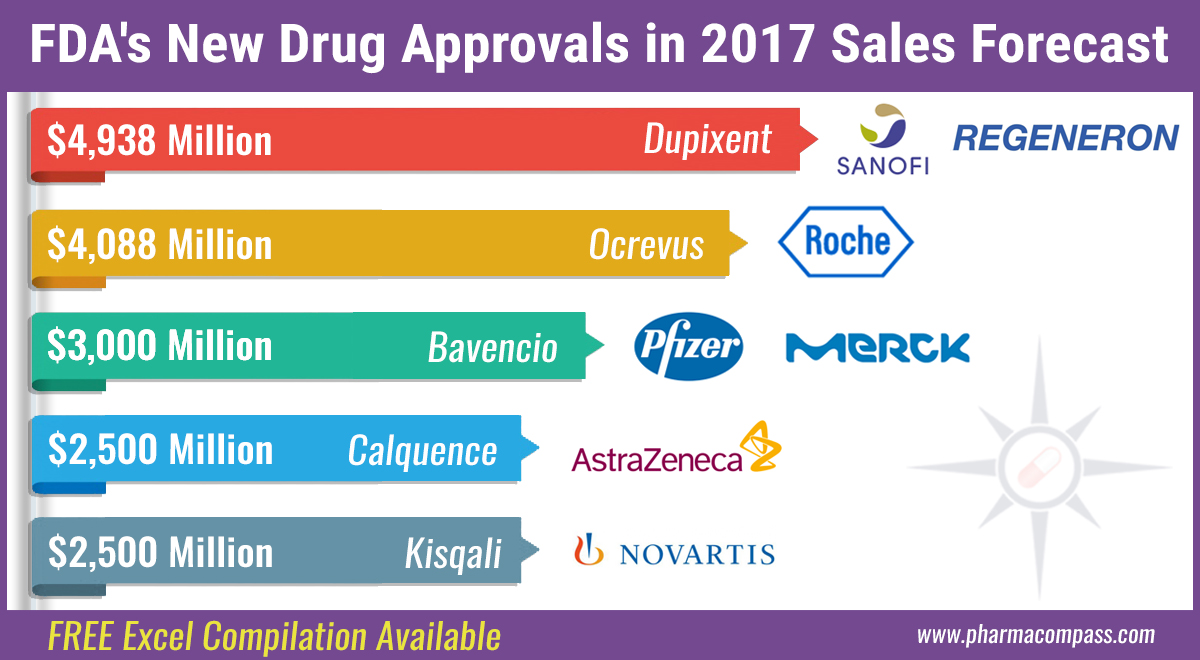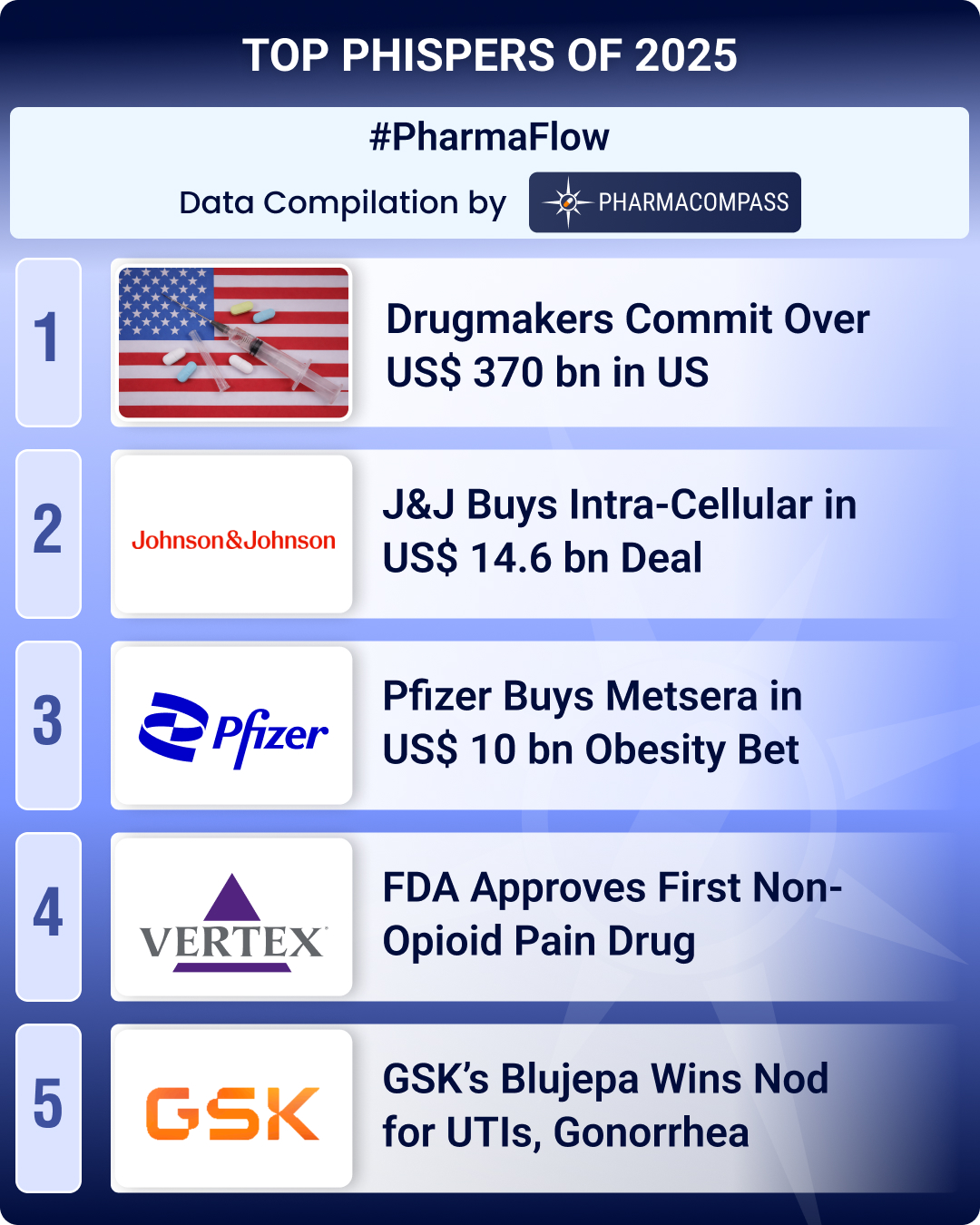
2017 was a landmark year for the pharmaceutical industries in the US and Europe, with a sharp increase in the number of new molecular entities (NMEs) being approved in both the geographies.
The US Food and Drug Administration (USFDA) approved 46 NMEs in 2017, a strong bounce back from only 22 NMEs approved in 2016.
The 46 approvals by the USFDA’s Center for Drug Evaluation and Research (CDER) is the second highest total since 1996 when 53 NMEs were approved.
In Europe, the European Medicines Agency (EMA) approved 35 drugs with a new active substance, up from 27 in 2016. We also identified eight drugs that got approved in Europe before winning the USFDA nod.
This week PharmaCompass shares its compilation of the 46 novel drugs approved in the US, of which 34 (or 74 percent) were small molecules and 12 (or 26 percent) were biologics, which were approved by the USFDA.
Click here for our list of FDA’s Novel Drug Approvals in 2017 (Excel version available) for FREE!
We have also evaluated these new drug therapy approvals with regard to their estimated sales potential. While the sales estimates of a new drug are far from certain, our effort is directed at providing insights into the potential these drugs hold along with attempting to identify emerging market trends.
An
overview of USFDA’s approvals
The USFDA’s CDER focusses extensively on the approval of novel drugs “which are often among the more innovative products in the marketplace, and/or help advance clinical care by providing therapies” that have never before been marketed in the United States.
In addition, CDER also looks at new and expanded uses of USFDA-approved drugs. In 2017, the CDER also worked on approving five new biosimilar drugs, which are highly similar to the USFDA- approved therapeutic biological products.
Click here for our list of FDA’s Novel Drug Approvals in 2017 (Excel version available) for FREE!
New formulations or new manufacturers of USFDA-approved products that can provide advantages over original products, such as being able to take the drug on an empty stomach and not with food, were also approved.
New dosage forms entered the market that add value to already approved drugs, such as chewable tablets for patients unable to swallow pills and Abilify MyCite (aripiprazole tablets with a sensor).
Aripiprazole was first approved by the USFDA in 2002 as a tablet to treat patients with schizophrenia and was marketed under the brand name Abilify.
In 2017, Abilify MyCite was approved as a tablet which contains an electronic sensor. Abilify MyCite allows the patient to track whether he or she has taken the medication via a smartphone or the cloud.
Patients can also give their caregivers or physicians access to the information through a web-based portal.
Click here for our list of FDA’s Novel Drug Approvals in 2017 (Excel version available) for FREE!
In the list of 2017 approvals, CDER identified 15 of the 46 novel drugs approved in 2017 (33 percent) as first-in-class while 18 drugs (39 percent) were approved to treat rare or “orphan” diseases that affect 200,000 or fewer Americans.
Of the 46 novel drugs approved in 2017, 36 (78 percent) were approved in the United States before receiving approval in any other country.
The American stars of 2017, by sales revenue
Of all the drugs approved by the USFDA, the highest expectations are from Regeneron and Sanofi’s first-in-class monoclonal antibody (mAb) — dupilumab. The (IL)-4 receptor subunit-α antagonist has shown benefits in various kinds of inflammatory and allergic diseases.
While the USFDA approved the drug for atopic dermatitis, it is also being developed for asthma, chronic obstructive pulmonary disease (COPD) and other indications.
Evaluate Pharma analysts estimate the sales of dupilumab at US$ 4,938 million by 2022.
Click here for our list of FDA’s Novel Drug Approvals in 2017 (Excel version available) for FREE!
Expectations are also high from two other mAb products. Genentech and Roche’s anti-CD20 mAb ocrelizumab for relapsing and primary progressive forms of multiple sclerosis is expected to bring in US$ 4,088 million by 2022 while Pfizer’s avelumab, an anti-PD L1 cancer drug co-developed along with Merck KGaA, which was approved to treat metastatic Merkel cell carcinoma, is expected to achieve peaks sales of US$ 4-6 billion with an estimated US$ 3 billion in annual sales for Pfizer.
In late 2015, AstraZeneca partnered with Acerta Pharma to develop a potential best-in-class irreversible oral Bruton’s tyrosine kinase (BTK) inhibitor — acalabrutinib.
AstraZeneca acquired 55 percent equity in Acerta for an upfront payment of US$ 2.5 billion and should have completed its payment of an additional US$ 1.5 billion now that the USFDA has approved the cancer drug, which is estimated to have peak sales of US$ 2,500 million.
Click here for our list of FDA’s Novel Drug Approvals in 2017 (Excel version available) for FREE!
Also expected to bring in US$ 2,500 million in sales is Novartis’ treatment for postmenopausal women with a type of advanced breast cancer — ribociclib. While the USFDA approved the drug in March 2017, the EMA approved it in August 2017.
The
European specials of 2017
While many drugs were approved in the United States before being approved in Europe, PharmaCompass has identified 8 active substances which have not been approved in the US but got EMA approval in 2017.
AstraZeneca’s treatment for hyperkalaemia — Lokelma (sodium zirconium cyclosilicate) — got approved by the EMA. However, the FDA did not approve it after the agency raised concerns over the manufacturing of the drug following an inspection of the facility.
Lutathera — a nuclear medicine targeted at the type of cancer that killed former Apple Inc co-founder and CEO Steve Jobs — got approved by the EMA and its developer Advanced Accelerator Applications (AAA), who in turn got bought over by Novartis for US$ 3.9 billion.
The application for Lutathera has been filed with the USFDA. Under the Prescription Drug User Fee Act (PDUFA), the agency is scheduled to make a final approval decision this week (on January 26, 2018).
Tivozanib (Fotivda, an oral, once-daily, vascular endothelial growth factor or VEGF) tyrosine kinase inhibitor (TKI) discovered by Kyowa Hakko Kirin and approved for the treatment of adult patients with advanced renal cell carcinoma was also approved in Europe before getting the nod in the US.
Our view
While the USFDA’s CDER approved the highest number of drugs in two decades, the approvals of the year were done by USFDA’s Center for Biologics Evaluation and Research (CBER) which approved two cell-based gene therapies.
Novartis’ Kymriah (tisagenlecleucel), the first-ever gene therapy — known as CAR-T (short for chimeric antigen receptor T-cell) — was approved for certain pediatric and young adult patients with a form of acute lymphoblastic leukemia (ALL).
In its press statement, the USFDA described this as a “historic action”.
CAR-T is a type of cancer immunotherapy that harnesses the body’s immune system to fight cancer cells. In this case, the therapy removes a person’s cells, reengineers them and then puts them back in their body to attack cancer cells.
In CAR-T therapy, every single dose of the treatment is unique and completely personalized to the patient. The Novartis drug came with a list price of US$ 475,000 for a one-time treatment.
Click here for our list of FDA’s Novel Drug Approvals in 2017 (Excel version available) for FREE!
Gilead also bet big on the technology and acquired Kite Pharma for US$ 11.9 billion in August. The USFDA also approved Kite’s most advanced CAR-T therapy candidate — axicabtagene ciloleucel (axe-cel).
Gilead announced a price significantly lower than the launch price at which Novartis is selling its CAR-T treatment (Kymriah).
With Novartis and AstraZeneca getting three therapies approved, Pfizer, Roche, Valeant and the team of Sanofi and Regeneron bagging two each and almost half the drugs approved by the USFDA’s CDER in 2017 expected to generate more than US$ 1 billion in sales, things look promising for innovation in pharmaceuticals and also provide interesting opportunities for generic drug manufacturers.
Click here for our list of FDA’s Novel Drug Approvals in 2017 (Excel version available) for FREE!
The PharmaCompass Newsletter – Sign Up, Stay Ahead
Feedback, help us to improve. Click here
Image Credit : FDA's New Drug Approvals in 2017 Sales Forecast by PharmaCompass is licensed under CC BY 2.0
“ The article is based on the information available in public and which the author believes to be true. The author is not disseminating any information, which the author believes or knows, is confidential or in conflict with the privacy of any person. The views expressed or information supplied through this article is mere opinion and observation of the author. The author does not intend to defame, insult or, cause loss or damage to anyone, in any manner, through this article.”





